We’re back! Did you miss me? Don’t answer that please. Today’s episode kicks off Season FIVE of Flash Forward. This year, I’m doing things a little bit differently. Instead of doing a new episode every other week, you’re getting little mini-seasons. Each little block of five episodes will come out weekly, and center around a theme. This week we’re starting our EARTH series. Five episodes, five different future Earths. Buckle up, I hope you’re ready for some fun. And some terror. This is Flash Forward, after all.
Today we travel to a future where humanity decides to pull the climate emergency break, and spray sulphuric acid into the upper atmosphere.
Guests:
- Anthony Jones, climate model researcher at University of Exeter
- Jane Flegal, climate science and policy advisor, program officer at The Bernard and Anne Spitzer Charitable Trust
- Kate Marvel, climate scientist at Columbia University and NASA Goddard Institute for Space Studies
- Romaric Odoulami, climate scientist at the University of Cape Town
- Prakash Kashwan, political scientist at the University of Connecticut
Further Reading:
- A critical look at geoengineering against climate change (David Keith TED Talk)
- Research on global sun block needed now
- Toward a Responsible Solar Geoengineering Research Program
- Benefits, risks, and costs of stratospheric geoengineering
- Stratospheric controlled perturbation experiment: a small-scale experiment to improve understanding of the risks of solar geoengineering
- Climate engineering needs a clean bill of health
- Climatic impacts of stratospheric geoengineering with sulfate, black carbon and titania injection
- Transient climate–carbon simulations of planetary geoengineering
- Regional Climate Impacts of Stabilizing Global Warming at 1.5 K Using Solar Geoengineering
- Sensitivity of volcanic aerosol dispersion to meteorological conditions: A Pinatubo case study
- Messing with nature? Exploring public perceptions of geoengineering in the UK
- Asymmetric forcing from stratospheric aerosols impacts Sahelian rainfall
- Crop yields in a geoengineered climate
- Recognitional Justice, Climate Engineering, and the Care Approach
- Engaging the Global South on climate engineering research
- Evoking equity as a rationale for solar geoengineering research? Scrutinizing emerging expert visions of equity.
- Forum on climate engineering
- Experiment Earth: Responsible innovation in geoengineering
- Ethics and geoengineering: reviewing the moral issues raised by solar radiation management and carbon dioxide removal
- Stratospheric aerosol injection research and existential risk
- India Should Demand International, Political Oversight for Geoengineering R&D
- Governing Solar Radiation Management: A Report from the Academic Working Group on Climate Engineering Governance
Actors:
- The Snowglobe Narrator: Brent Rose
- Lenny Haywood: Evan Johnson
- Farah Mousterian: Zahra Noorbakhsh, host of Good Muslim, Bad Muslim
- John Jacob Siwa: Joseph Jones
- Juana Aguilar: Tamara Krinsky
- Thor Surtr: Oliver Blank, host of The One that Got Away
Flash Forward is produced by me, Rose Eveleth. The intro music is by Asura and the outtro music is by Hussalonia. The episode art is by Matt Lubchansky. Special thanks this episode to the Women Audio Mission studios, Maryam Qudus, Stephanie Lopez, The Potluck Podcast studio, the Potluck Podcast Collective and Quincy Surasmith.
If you want to suggest a future we should take on, send us a note on Twitter, Facebook or by email at info@flashforwardpod.com. We love hearing your ideas! And if you think you’ve spotted one of the little references I’ve hidden in the episode, email us there too. If you’re right, I’ll send you something cool.
And if you want to support the show, there are a few ways you can do that too! Head to www.flashforwardpod.com/support for more about how to give. But if that’s not in the cards for you, you can head to iTunes and leave us a nice review or just tell your friends about us. Those things really do help.
That’s all for this future, come back next time and we’ll travel to a new one.
FULL TRANSCRIPT BELOW
▹▹ ▹▹ ▹▹ ▹▹ ▹▹ ▹▹ ▹▹ ▹▹ ▹▹ ▹▹ ▹▹ ▹▹ ▹▹ ▹▹ ▹▹ ▹▹ ▹▹ ▹▹ ▹▹ ▹▹ ▹▹ ▹▹ ▹▹
Rose: Hello and welcome to Flash Forward. I’m Rose and I’m your host and we’re back! Did you miss me? Well, even if you didn’t, I’m back! Happy 2019! If you’re new to Flash Forward, here’s the deal: every episode we take on a specific possible or NOT so possible future scenario. We start each episode with a little fictional field trip into the future, to set the stage and check out what’s going on, and then we zip back to today to talk to real experts about how that future might really unfold. Got it? Great.
A quick note on scheduling before we get into today’s episode: This year, I’m trying something a little bit different with the way Flash Forward unfolds. Instead of a new future coming out every other week for forty weeks, I’m working on a set of mini-seasons each based on a theme. So today’s episode is the first of five episodes in our Earth mini-season. You’ll get an episode a week for each of these mini-season, and then the show will take a little break until the next mini-season begins. Make sense? Okay, great, let’s go to the future! Today, we’re going to start in the year 2038.
Narrator: Everybody thinks they’re on the verge of the next million dollar idea. But do they have what it takes to really make it big? It’s time to find out. Real entrepreneurs. Real investors. Real success. But don’t expect anything warm and fuzzy. Welcome to THE SNOWGLOBE. Let’s meet the bears.
Lenny Haywood, a renegade entrepreneur and billionaire who not only owns the Seattle Supersonics, but also plays for them.
Lenny Haywood: Traditional investing bores me — if you play it safe, I’m out. Shock me with some deviant behavior, show me something I haven’t seen, and trust me, I’ve seen a LOT.
Narrator: Farah Mousterian: the daughter of Iranian immigrants who went on to become a technology mogul like the world has never seen, selling her first startup for 4 billion at the age of 15 and never slowing down.
Farah Mousterian: I don’t invest in spoiled rich kids. If you can’t prove your concept when you’re broke, you won’t be able to prove it with money either.
Narrator: John Jacob Siwa, a fashion icon turned fashion mogul who doesn’t just walk the runway, he owns it, literally.
John Jacob Siwa: To me, a good investment is like porn, I know it when I see it. It’s that simple, I can just feel it in my gut whether it’s a yes or a no.
Narrator: And Juana Aguilar, a venture capitalist who has taken hundreds of businesses under her wing to form the world’s largest and most profitable corporation conglomerate worth nearly a trillion dollars.
Juana Aguilar: If you don’t have your numbers down, I’ve got no time for you. Entrepreneurs should know their balance sheets inside and out. If you can’t do the math in your head in the globe, why should I trust you can do it in your office?
Narrator: The bears will hear from the world’s best, brightest and savviest inventors. For some, it will be heartbreaking
Roberta: It’s not paranoia, it’s science!
Lenny: Are you kidding me?
John: She’s trying to rip you off!
Amy: Can you give me a second to think, please?
Farah: Oh my god we’re all going to die.
For others, it will turn into the opportunity of a lifetime.
John: These are nice!
Kevin: This is the future of building ladies and gentlemen!
Christina: Who wants to dive in, the water’s empty!
Farah: We’re going to make some money before society collapses girls!
Let’s step into the globe. [whoosh]
[wheels squeaking, Thor is wheeling a little table out with a children’s volcano diorama on it towards the sharks)
Thor Surtur (inventor): Many of you are probably familiar with this — a classic children’s science experiment. [shuffling]
If I add vinegar, here, [starts to erupt] aha, I get a volcanic eruption. [messy sound]
But what if I told you that THIS could be the key… to saving our planet.
It all comes down to something called sulfate. I’ve brought you each a little vial. [hands them out] Inside each of these vials is
Lenny Haywood [kind of annoyed]: Nothing
Thor: Ah it just LOOKS like nothing. Inside each of these vials is something called sulfate aerosols. And whenever a volcano erupts, along with the lava and ash, it also sends huge amounts of these sulfate aerosols into the atmosphere. And those aerosols reflect the sun, and cool the planet.
Now… you may have heard of climate change. Doom and gloom, right? Droughts, and flooding, and famine, and polar bears dying and all that. It’s bad, or, it’s going to get bad, unless we DO something. And this… is what we can do. By harnessing the power of the invisible stuff in those bottles you’re holding, we can keep the planet from getting any hotter. All we have to do is put sulfate aerosols into the atmosphere. And that, is precisely what my company can do.
Nephele is is going to deliver a highly calibrated cocktail of planet saving sulfates into the upper atmosphere. We’re going to stop global warming, and ensure that our children, and our children’s children, will still be able to live on this planet. This is your chance, bears, to save the world.
John Jacob Siwa: Too weird. I’m out.
Lenny: So… how does your company … make money.
Thor: You’d save the planet.
Lenny: Right I heard that part, but you’re asking me to spend my money and I spend my money on things that I can get some kind of return on…
Thor: [talking over him] Saving the planet isn’t enough?
Lenny: [even more annoyed] And what I’m NOT hearing here, is how your company actually plans to make any money.
Thor: You’d have the best PR in the world. This is the guy who saved the planet. Don’t you want to be that guy?
Lenny: Sure I want to be that guy AND ALSO MAKE MONEY.
Thor [pleased with himself]: Okay, I thought you might ask that. If saving the world isn’t enough … there’s more. The thing about this kind of artificial volcano, is that it’s very effective. But once you start using these miraculous particles in the atmosphere, you can’t stop suddenly. If Nephele were to suddenly stop delivering its regularly scheduled aerosols to the atmosphere, it would throw the planet into something called termination shock. All the warming we’d been putting off would happen almost overnight, and the Earth would be plunged into complete chaos.
Lenny: [interrupting]: This isn’t really helping your case…
Thor: SO, what the means, is that once we begin this project, countries all over the world will have an incentive to pay us to continue it.
Juana [laughing]: That’s extortion, you’re describing extortion. Pay us or we’ll destroy the Earth! You’re a supervillain.
Thor [nervous]: No, it would simply be a win win for both sides. But if you’re that set on a more traditional investment, there are always the airplanes.
Lenny: Here is where you say more.
Thor: Okay so for this to work, the aerosol has to be delivered to the upper atmosphere. Otherwise it doesn’t stick around long enough to do much, and you’d constantly have to be pumping it up there. You need a plane that can carry the sulfates into the upper atmosphere — you really don’t want to deliver the aerosol below about 12 miles and ideally you’re hoping to distribute it at around fourteen miles up. Your private jets that you all have, they fly at about 7 and a half miles up. So you need specialty aircraft to make this work.
Juana: And you have these planes?
Thor: We have four of them.
Juana: Who else has these planes.
Thor: Only a handful of military operations around the world. The US, China, Russia.
Lenny [incredulous]: So let me get your pitch right, correct me if I’m wrong here, I’m just trying to understand. You want to pump a bunch of volcano stuff into the atmosphere to cool the planet, and then vaguely threaten to stop putting it up there unless countries around the world pay you or buy your planes to do it themselves?
Thor: No, I am trying to save the world. You’re the one who wants a business plan.
Lenny: That’s the point of this show!
Juana: So how much money are we talking about here.
Farah Mousterian: You’re kidding me, you’re not really asking for numbers? This is crazy!
Juana: I just want to know, I’m just curious!
Thor: Yes! You invested in the sea robot cleanup, you understand.
Juana: Yeah, well, that didn’t work, so it was a pretty expensive PR investment. Probably not worth reminding me of that one.
Thor: Oh this will work, I guarantee it. So I’m asking for four billion to save the planet, in exchange for 20%.
Juana: 4 billion, with a b. And where is that number coming from?
Thor: Scientists have already done the math, they say it will cost 3 billion dollars a year all told to keep this kind of system up and running. I already own the planes, and can pay off their annual cost with other contracts. I can put in my own four billion to match, and that gets us about three years of climate remediation.
Lenny [laughter]: I’m out.
Juana: Are the planes owned by Nephele or are they a separate business.
Thor: They’re separate.
Farah: [interrupting] Juana are you kidding me? This is super villain territory. You cannot actually be considering this!
Juana: I don’t care about the spray stuff, whatever, but those planes are really hard to find and could be useful to me.
Thor: It’s a separate business.
Farah: You can’t just spray chemicals into the air!
Juana [ignoring her]: What if I want in just on the planes?
Thor: No deal, I’m here to save the world.
Farah: Oh my god.
Juana: 1 billion for 40% of the plane company, only.
Juana: And you don’t put my name anywhere on any of this spraying stuff. That’s your thing.
Thor: 30%
Juana: Nope, I’m firm at 1 billion for 40%. I’m sure you can spray lots of whatever into the air with that kind of money.
Thor: …. deal.
Farah: Oh my god we’re all going to die.
Lenny: [laughing] You’re a supervillain now! Congrats!
Rose: Okay, so today we’re talking about geoengineering. And specifically, about something called solar radiation management.
Anthony Jones: So there are quite a few different ways of cooling the planet by brightening the surface or by brightening the atmosphere.
Rose: This is Anthony Jones, a researcher at the University of Exeter in the UK. And Anthony mostly looks at a specific type of solar radiation management called sulfate aerosol injection. Which is convenient, since that’s also the type of geoengineering that this episode is about!
Anthony: When a sulfate gets into the stratosphere, it stays there for for a couple of years, it’s very long lived. And it reflects sunlight and it cools the planet. The reason why people have always looked at sulfate is because this is what volcanic eruptions emit into the atmosphere, such as the Mt. Pinatubo eruption in 1991.
Rose: When Mount Pinatubo erupted, it injected about 15 million tons of sulfur dioxide into the stratosphere. And scientists were able to actually see the cooling effect of those sulfate particles in real time. Over the next 15 months, the average global temperature dropped by about 1 degree Fahrenheit. What this means is that researchers have basically a natural experiment on geoengineering to look at, and to test their models against.
Anthony: What most climate modelers do, is they use the volcanic aerosol scheme – which is already in a climate model – and they just adapt it for the geo-engineering purposes. So it is like an endless volcano in a way.
Rose: So, one of the reasons geoengineering – and specifically solar radiation management – is really interesting to me, is because it’s kind of been this idea in limbo for a really long time. People have proposed this endless volcano plan, this idea of spraying stuff into the atmosphere, for over 30 years. And their argument in favor of this plan has pretty much always gone like this: humans have warmed the planet at a pace far beyond any kind of natural cycle. A big chunk of anthropogenic climate change is irreversible, and thus far our attempts to cut emissions haven’t really gone anywhere. Pretty much everybody agrees that the likelihood of humans staying below the Paris Agreement target of 1.5 degrees Celsius of average overall warming is very, very low. Geoengineering, and specifically sulfate aerosol injection, is kind of a way to pump the breaks a little bit, and buy us some more time.
Probably the most famous advocate for solar radiation management research is a guy named David Keith, who’s a physicist at Harvard University. Here he is talking about this idea in a TED talk from 2007.
David Keith: You could put fine particles, say sulfuric acid particles — sulfates — into the upper atmosphere, the stratosphere, where they’d reflect away sunlight and cool the planet. And I know for certain that that will work. Not that there aren’t side effects, but I know for certain it will work.
Here he is again, on the Colbert show a few years later…
David: You could actually spray sulfuric acid in the stratosphere, 20 kilometers over our head, and use that to stop the planet warming up
Stephen Colbert: You can spray something into the atmosphere to change… okay…
David: Spray pollution into the atmosphere to stop it warming. This doesn’t, in the long run, mean that you can forget about cutting emissions. We will need to rein in emissions.
Stephen: No, we’ll get to it eventually. But in the meantime, we’re shrouding the earth in sulfuric acid.
David: So people are terrified about talking about this, because they’re scared that it will prevent us cutting emissions.
Stephen: Right, and also that it’s sulfuric acid.
Rose: So, before we get into the question of whether we should do this, let’s talk about how this might, in theory, work. In order to devise a solar radiation management system, the first question you have to answer is how you’re even going to get these sulfur particles into the atmosphere in the first place. Because for this to really work, you do want to inject these sulfate particles really high up in the atmosphere. If you inject them too low, they just kind of fall out of the sky. But up at about 25 kilometers above the surface of the Earth, which is about 15 miles up, there’s this current of air that travels all the way to the North and South poles. So that’s probably where you want to spray your sulfates.
Which means you can’t really do this with a regalar commercial airplane that you or I might use to fly home for the holidays. You need special, high altitude aircraft. Or… you could try some of the other ideas out there.
Anthony: Other suggestions include balloons, which tether to the surface by by hose pipes. And other unusual suggestions, such as towers emitting…. there are lots of unusual suggestions.
Rose: Plenty of unusual suggestions indeed, but in fact, and this is a really important thing to say, nobody is doing this. Nobody is doing active sulfate aerosol experiments. Not even small scale ones. I say this for two reasons, one because if you google sulfate aerosols or solar radiation management, or even David Keith, you’ll pretty quickly find a lot of people who believe that this is currently happening, that the government is currently, actively spraying chemicals into the atmosphere. Under almost every video and every talk that any geoengineering researcher does, there are hundreds of comments about chemtrails and government conspiracies. Everybody that I’ve talked to says that is not happening. The research of solar radiation management right now is almost 100% theoretical, based on modeling and computer simulations. There is a project at Harvard, that David Keith is involved with, called the SCoPEx project, and they’re working on some experiments involving a balloon, but their work is not about delivery. They are not spraying tons of this stuff into the atmosphere, the way that people who make YouTube videos about chemtrails claim that they are.
The second reason I’m pointing out that almost nobody is doing on the ground experiments here, is because it means that everything we’re about to talk about is theoretical.
Jane Flegal: It’s absurd. I say to people, now that I’m not a geoengineering researcher exclusively, it’s really difficult to study a thing that doesn’t exist for a long time before you’re like, “what am I doing?”
Rose: This is Jane Flegal, a researcher who’s spent years working on geoengineering policy and ethics, and who currently works on climate philanthropy. And for her, the theoretical nature of solar radiation management can actually get kind of frustrating. Because without knowing how this might actually work in real life, it’s hard to say how much it will cost, or what the impacts will be, or what the best implementation is. Which means that it’s hard to make decisions about whether we should even do it.
Aside from this new SCoPEx project at Harvard, there have only been a tiny handful of outdoor experiments on solar geoengineering ever conducted. One of them happened ten years ago, when some researchers in the UK conducted something called the SPICE experiment.
Jane: Which was basically spray a bathtub of water into the sky.
Rose: Sounds simple enough, right?
Jane: And there was an engineer on that project who told me that the hose that they were going to use to spray the stuff just didn’t work. It was too slack, there was a hole in the hose because of the way it had been attached to the spool it arrived on. That’s the real world. That’s the kind of messy real world way that this might play out.
Rose: As with most technologies, and certainly most planet sized technologies, this is not really as easy as a lot of people make it sound. There are a ton of unanswered questions about how… exactly… this might or might not work. Even if they figure out how to get the stuff up there, nobody knows how much is the right amount to spray. And scientists also don’t know for sure that the particles they’re spraying will behave the way they want them to.
Anthony: That’s one thing that I’m quite interested in is the sensitivity of solar geoengineering to the the amount of injection, simply because I think the aerosols will become quite large for a large amount of injection.
Rose: So what you’re saying is, that at very low levels of injection, it doesn’t do anything; but if you inject too much, they can clump together, and also not be effective?
Anthony: Yes, absolutely, yeah.
Rose: And yet, despite there being very little engineering research on this to iron out the logistics, lots of people love to say that this is going to be cheap and easy and really effective.
Anthony: Most of our current climate models say that solar geo engineering would be would have almost limitless effectivity, and I don’t really believe that
Jane: My least favorite geoengineering trope is like, “oh, it’s cheap and easy.” I just can’t stand it. And what people usually mean, when they say that is, like some guy could fly a plane and spray stuff. Which, sure, yeah maybe.
Rose: But one guy with a plane, does not a study make! Without on the ground tests we have no idea if this will actually be cheap.
Jane: I mean, again, given how thin the evidentiary basis is, and that there is not any engineering studies, I just think that’s a crazy claim to be making. And there’s very little empirical evidence that even doing research is cheap and easy, since nobody seems to be doing it.
Rose: And nobody has been doing it… for a long time at this point. That David Keith TED talk that I played for you, that’s from 2007 but he’s been working on this idea since 1992. And he loves to point out that this idea has been in the air all the way back to President Lyndon Baines Johnson. In 1965, LBJ’s science advisory committee issued a report called “Restoring the Quality of Our Environment,” and that report actually talks about climate change and CO2, and even discusses geoengineering. Way at the end, in the appendix, the report talks about ways to counteract the effects of CO2 by changing the reflectivity of the Earth, which is also called the albedo of the Earth. The authors write:
Such a change in albedo could be brought about, for example by spreading very small reflecting particles over large oceanic areas.
This is all to say that scientists have been proposing this so called cheap and easy method for over 30 years, and even maybe as long as 50 years. And yet, despite this long history, there have still been basically no field tests, no engineering tests. All the while, the idea still hangs around in our collective imagination. And I wanted to know… why?
Kate Marvel: I think it’s possible to tell this sort of really hopeful story; that we we got together and we used science and we used global cooperation and we figured out how to fix this problem.
Rose: This is Kate Marvel, a climate scientist at Columbia University and the NASA Goddard Institute for Space Studies.
Kate: There’s kind of a Star Trek utopia thing about it, where maybe the generations before us, they baked this problem into the system, and they gave us this flawed system. And we’re still disentangling ourselves from the flawed system we inherited, but we fixed the immediate problem. So I actually think that’s a that’s a really appealing story for a lot of people.
Rose: And I get this, actually, I really, really do. Climate change feels totally impossible sometimes, right? I mean, what really are the chances that we’re going to convince billionaires to change their ways and maybe make a little bit less money so that the rest of us can live? Wouldn’t it be nice if there was just an app you could buy, or a gadget you could install to just… fix it? It’s like when you’re really stressed, and totally freaking out about, say, your podcast relaunching and you hope that maybe just downloading the right meditation app will fix all your problems. Just…. For example.
Kate: It’s like you go to the doctor, and they give you this diagnosis, and they give you a course of treatment, and you’re like, “I don’t want to do that. What else can I do?”
Well the what else is is almost always going to be sub-optimal to treating the underlying cause. But it can be tempting. You know, maybe your insurance will pay for it, but it won’t pay for the cure. Maybe you are frightened of the cure, and that’s going to require stuff that you don’t want to do. But I think we need to be very explicit that this is not a cure.
Rose: And, like so many quick fixes, solar radiation management comes with…. Some side effects.
[On the phone] Do you think it’s a good idea to try this?
Anthony: No, I don’t think it’s a very good idea. I think it’s an interesting question, in a way, and to be honest I look at solar geoengineering, or I research solar geoengineering, mainly because it’s actually a really good deterrent in a way? Because a lot of people really take notice of climate change when you tell them that we’re looking at these really sci-fi ideas to cool the planet. They suddenly say, “well actually, there must really be an issue here.”
Rose: Anthony thinks this is such a bad idea that he actually does this research to try and convince people not to do it.
And one of the reasons he’s convinced that this is not a good plan, is that the effects of solar radiation management, at least the ones that models can help us guess at, are going to be unevenly distributed. Some parts of the world will be better off, and some parts of the world will… not. And when we come back, we’re going to talk about what that distribution looks like… but first, a quick word from our sponsors.
[[AD BREAK]]
Rose: Okay so, let’s say we figure out a delivery mechanism, we figure out how much to use, and we figure out how to make the sulfate particles actually stay separated instead of clumping together. Let’s say it is somehow affordable enough to consider. These, again, big assumptions, but… let’s just go with them. Let’s pretend that everything goes according to plan, just as we expect. Would the plan actually work? Do these models say that spraying sulfates into the atmosphere would really, truly, cool the planet enough to stave off catastrophic climate change?
Anthony: The Paris target of 1.5 degrees could quite easily be achieved with solar geoengineering. You wouldn’t need to inject much aerosol into the stratosphere to cool the planet in the near future, and to maintain global warming at 1.5 degrees above pre-industrial levels.
Rose: In other words, yes. In theory, based on these models, this would work. But… and you knew there was a but coming right? It isn’t that simple. This 1.5 degree target, the one that everybody always talks about, the one set by the Paris Agreement in 2015, it’s kind of a red herring. That 1.5 degrees is a global average temperature, and when it comes to thinking about something like geoengineering, you can’t just look at the average.
Kate: I don’t care about the global average temperature, and you know nobody cares about that, right? Nobody experiences that. What we care about are the effects of that. We care about local temperatures. We care about extreme events like droughts and floods and heat waves. And we care about rainfall patterns.
Rose: That 1.5 number is kind of like a symbol. If we can reach it, it means that we’ve cut emissions and changed a lot of our behavior. And, in that way, it’s good. It’s a symbol that represents that we’ve done it. But it can become dangerous when you use that number as the only goal.
Kate: You live in Silicon Valley now, right? Like, you know that when you give people a metric, you can sort of focus on achieving that metric. But it’s really easy to get tunnel vision and be like, “well, why are we actually doing this?”
Rose: In general, on average, putting sulfates into the atmosphere would probably help us check off that 1.5 degree average box. But on the ground, the models suggest that it stands to have a lot of different regional impacts. And one of the biggest problems with this proposal, right now, is that we don’t necessarily know what all of those impacts are — especially when it comes to places that are often overlooked in research programs. Not a lot of modeling studies are done in places like Southern Africa or India, and that’s for a couple of reasons.
Romaric Odoulami: The African continent, and also most of their developing countries in their world, which are considered as being the most vulnerable to climate change impacts; in those countries there is a lack of research activity on solar radiation management and its potential impact on the climate.
Rose: This is Romaric Odoulami, a researcher at the University of Cape Town. He recently started a project that will try and understand what the impact of solar radiation management will be in Southern Africa. Which is unusual, most of the climate modelling work is coming out of the US and Europe.
Romaric: Most studies on solar radiation management are theoretical, and climate models and climate models generally require a lot of computational resources. And, in most of our countries in Africa, and also some other developing countries of the world, those resources are not available.
Rose: A lot of climate modeling uses actual supercomputers, and state of the art networks and processors that can store and crunch huge amounts of data, which not everybody has access to. But there are a few reasons why it’s especially important to understand climate change in these exact regions.
Romaric: We already know that the Southern African region is highly vulnerable to climate extremes such as drought and heat stress
Rose: Romaric and his team are planning to have some results next year, and hope that with them they can help inform local governments about the risks and benefits of geoengineering. I’ll keep you listeners updated about Romaric and his teams finds, but now, let’s talk about the modelling studies that have been done so far, and what they suggeest.
Last year Anthony published a paper in a journal ominously titled Earth’s Future, walking through a handful of impacts their models predict. Let’s start with the winners.
Anthony: We found that stratospheric aerosol injection was very effective at mitigating the enhancement of tropical storms in the North Atlantic.
Rose: Those tropical storms can sometimes turn into hurricanes that hit the Eastern coast of the United States and the tropics. So that’s good, fewer big hurricanes like Maria, Sandy and Katrina.
Anthony: And it was also very effective at reducing the number of heat waves or hot days over Europe. And I’d say that heat waves is one of the main climate impacts affecting Europe.
Rose: In 2003, a heat wave in Europe and Russia killed over 70,000 people. And experts warn that heat waves will get more common under climate change. Avoiding that, using sulfate aerosols, would be a good thing.
And, in another study, one that Anthony wasn’t involved in, researchers found that it’s possible that crop yields might actually increase under geoengineering. That’s because CO2 is basically a fertilizer for plants, it’s crucial for photosynthesis. Under climate change, most of the benefits of all that extra CO2 are dampened by the heat stress that these plants are under. But in a world of solar radiation management, the CO2 is still there, but the hotter temperatures aren’t.
But there are some predicted losers here too.
Anthony: We found that the Amazon would become a much drier location.
Rose: In case it’s not obvious, taking the rain out of rainforests would almost certainly not be good for biodiversity. Models also suggest that monsoons would get worse all over the world.
So, some people have seen the results of these kinds of models, and responded by saying, “okay maybe, instead of trying to blanket the whole world in sulfates, we could do more targeted applications. Maybe if we just sprayed them in the Northern Hemisphere, we could get these nice impacts, and not have the bad ones.” Well, Anthony’s work suggests that even targeted applications have their drawbacks.
Anthony: We used our climate model and we injected aerosol for a long period of time in the northern hemisphere. And we found, indeed, that you do get this significant change in rainfall over the Sahel region.
Rose: The Sahel is a region of northern Africa — it’s basically a band that’s about 620 miles wide and that divides the Sahara from the Savanna. And from the 1970’s to the 1990’s the Sahel experienced a really bad drought that killed 250,000 people and created 10 million refugees. Scientists think that that drought was caused by a couple of things, one being some volcanic eruptions. And the other… being pollution.
Kate: We kind of did a little bit of this experiment already
Rose: This is Kate Marvel again.
Kate: Prior to the Clean Air Act, we burned a lot of really really dirty coal, and we put a bunch of sulfur dioxide, not all the way up into the stratosphere, but into kind of the lower atmosphere. And we did a pretty good job of blocking a lot of sunlight just from pollution from power plants and transportation.
Rose: And just like you can see the effects of the Mount Pinatubo eruption, you can see the effects of this pollution too.
Kate: There is a really powerful effect from all those aerosols, all that gas and dust that we kicked into the atmosphere. And when you mentioned the Sahel, we think there’s a pretty strong signal of that human – not greenhouse gases but what we call aerosols, that gas and dust – blocking the sun, cooling the North Atlantic down. And we think that played a major role in the devastating droughts in the Sahel in the 80s.
Rose: Not everybody is in total agreement here that the Sahel drought, which the UN calls one of the largest humanitarian disasters of the last 50 years, was caused by pollution. Some people think it was the result of natural climate cycles. Of course, those two things aren’t mutually exclusive either. It could be a little bit of both. And this gets us into a thorny problem with geoengineering. If we do this, and a huge drought does hit the Sahel, or a monsoon hits South Asia, it’s going to be really hard to conclusively say that geoengineering was to blame.
Kate: If China gets hit by a typhoon, and the Chinese government is convinced that this is attributable to solar radiation management, does it matter the extent to which it actually is attributable. Is it the perception that matters or is it the you know the actual attribution? That’s fundamentally always going to be kind of a statistical thing. And so, how do you how do you deal with that?
Rose: We’re going to come back to the political questions here in a second, but before we do, it’s worth also noting that along with all these potential negative impacts, there are some important things that solar radiation management doesn’t help with at all.
Anthony: Ocean acidification is related to the amount of carbon dioxide in the atmosphere
Rose: When the ocean absorbs CO2, it reacts with the sea water to form carbonic acid.
Anthony: And this is what acidifies the oceans, and can lead to things like coral bleaching and coral reef destruction.
Rose: Solar radiation management would do nothing to help here
Anthony: Because solar geoengineering does nothing for reducing the amount of carbon dioxide which is being emitted into the atmosphere.
Rose: Oh also, there’s one last catch. Let’s say we decide to do this, we decide that we need to pull the emergency brake, and buy some time, while we try and fix the rest of these sticky climate problems, and we start spraying sulfates into the atmosphere. Once we start doing this… it’s unclear if there is a safe way to stop doing this.
Anthony: If we were ever to stop geoengineering suddenly, we’d have this massive climate shock where the climate would rebound to the state it would have been if no new engineering would have occurred and we call this the termination shock.
Rose: Termination Shock is a great band name.
Anthony: And this basically means that you get all of your climate change within five or 10 years, and this means like three or four degrees warming within five or 10 years, depending on how much to geoengineering you were doing at the time, and this is rather worrying.
Rose: Okay, so… sulfate aerosols are not a panacea. But maybe it’s better than global climate disaster? If we really aren’t going to get our butts in gear and stop emitting, maybe this is worth considering? But… who gets to decide if we do this? And given that we know there will be disproportionate impacts of this technology, should some people have more of a say than other people? All these ethical questions and more, when we come back. But first a quick word from our sponsors.
[[ADS]]
Rose: Okay, so I’m about to do that thing where I tell you a bunch of stuff, and then I call into question everything I just said. So buckle up! All that stuff about the local impacts of spraying sulfates, it’s all based on modeling right? But models… are just pictures. They’re guesses. And often they’re pretty crude guesses.
Jane: You just turn down the sun, or imagine a uniform layer of aerosols in the stratosphere. And we’re not capturing a lot of important dynamics, like certain dimensions of atmosphere chemistry. There are a lot of questions about clouds and aerosol interactions. Lots of questions about ocean dynamics that just aren’t captured in the models.
Rose: This is Jane Flegal again.
Jane: If we are promising that deployment of solar geoengineering is going to produce X outcome in Y place on the basis of these models, they are not exactly the right tool for that job, in my view.
Rose: All that stuff I told you about what would happen in the Sahel, or in the Amazon, or in Europe under geoengineering, those are all just guesses. And it’s important to guess, of course, but it’s also important to be honest about how confident we are about those guesses.
Jane: We’re taking models that are kind of fundamentally exploratory, and trying to use them in a consolidated way, like as an engineering model.
Rose: It’s kind of like this: you go to an artist you ask them to paint a future city. They deliver something out of their imagination — using what they know about today’s buildings and cities, but also using their creative minds to envision what might be different tomorrow. That’s the model. But what’s happening now is that people are taking those paintings of a future, beautiful in their own right, and treating them like they’re architectural plans for the buildings in that future city. Which they’re not!
Some scientists are very clear about the limits of their models, and what they can and can’t say with certainty. Some are less clear. But it’s tricky, because when you start to question whether these models are the best way to think about future ethical climate decisions, you get into a kind of awkward place.
Jane: Modelers have been really assertive about the realism of their models in order to justify a set of actions in the face of climate. And this is one of the reasons geoengineering is tough, because if you are critical of the models as they are used for geoengineering, folks will often say well you might as well be a climate denier. Which is crazy, but a hard argument to fight against.
Rose: Some people react to the imprecision of these models by saying “well, we just need more data, this should be a reason to do more research into geoengineering, and to have more certainty about what the consequences might be.” And sure, we should probably do more research. But simply having more scientific data doesn’t always make ethical decisions easier.
Jane: There are plenty of examples of cases where more research on a question increases the uncertainties, it does not decrease them. Science cannot resolve value in political disputes. It just can’t. There are some folks who just have deep ethical and value based objections to tinkering with the climate in that way. They just think it’s a bad idea. No amount of science is going to change their view on that, or it’s really unlikely because it’s a value based proposition.
Rose: Even if we had perfect models, that perfectly predicted exactly what might happen if we did this — which… is unlikely — the actual decision making process for whether we SHOULD do this, is still going to be really complicated.
Prakash Kashwan: Presumably ethics are linked to the number of people who are affected as well as who is being affected as a result of the actions or inactions of another set of actors who may be more or less influential.
Rose: This is Prakash Kashwan, a professor of political science at the University of Connecticut. And he says that right now, there’s pretty much no specific overarching body that would decide if geoengineering could or should happen.
Prakash: As of now there are a couple of different global treaties that are potentially relevant.
Rose: There are treaties about environmental modification, for example. And treaties about marine pollution that might wind up being relevant.
Prakash: The United Nations Convention on Biodiversity Conservation is relevant because they passed a resolution that anything that might harm biodiversity has to be considered on a sort of precautionary basis, that we don’t do things that might potentially undermine the global agreements on conservation of biodiversity, and so forth.
Rose: Prakash was part of a team that wrote a report recently for the Academic Working Group on Climate Engineering Governance all about what should happen when it comes to the governance of solar radiation management. And in their report, the authors argue that because geoengineering is an inherently global effort, as many people as possible should have a say. And not just governments, but regular people too.
Prakash: So, if you think about global climate negotiations, these negotiations are dominated by national governments, some international NGOs and think tanks, and the United Nations institutions. But, there’s there’s an argument to be made and there’s some evidence to show that these actors and institutions have not adequately reflected the interests and the aspirations and the perspectives of the poor people of the world, or indigenous peoples who have a very different kind of relationship with nature and the environment.
Rose: And here is where we get into another one of the arguments that pro-geoengineering people make a lot. Which is that the rich Western countries have a duty, a moral obligation, to research geoengineering because they contributed most to climate change, and because climate change disproportionately impacts the global south. Here’s a clip from David Keith on a BBC Show called Hard Talk
David Keith: I think this moral tradeoff is a very puzzling one. If it works, and again we don’t know that it does, it provides some protection in the near term. And I think it is a very odd moral stance to say we should wish that such protection isn’t available, especially we in the rich world, when the consequences will fall mostly on the global poor.
Jane: You could think of taking responsibility as taking responsibility for someone in kind of a paternalistic way. Right? Where because we emitted more, we now are responsible for taking care of others, with their best interests at heart. And therefore we have a moral obligation to develop geoengineering technologies on behalf of the global poor.
Rose: Perhaps you can already tell, but Jane doesn’t really buy this moral argument.
Jane: But there’s a really different way to think about care and the ethics of care, too, that is more about empowering those who are not not currently empowered to develop these technologies themselves, just to think about these questions. There are different issues associated with agency and those two different framings, I think, that are really important.
Rose: And you can’t just do this by asking the leaders of so-called “poor countries” either.
Prakash: I wouldn’t necessarily equate the poorest actors with poorest countries, you know. There’s a lot of slip in that equating of countries with poor people. We know that even countries that are democratic, like India, they have democracies that are very imperfect. And so many times, because of a variety of factors that we all know very well about, national governments do not actually represent the interests of the majority of people in the country.
I think we need to move beyond this notion of thinking about countries as being the primary actors in the process.
Rose: This is why the report Prakash helped write recommended a body of non political actors, of actually regular people, who are given a true say in the process, and not just as a formality. Not in the way that this normally happens where the leaders actually make the decisions, but we bring in a couple of normal folks to make it look like we consulted them.
Prakash: You know, these poor people will talk on the side while we will make the most important decisions. We argue that those kinds of forums should have much more binding decision making powers, and their decisions should be considered at par with national governments if not more than that.
Rose: Instead of a bunch of wealthy people in wealthy countries saying “don’t worry, we’ll take care of you, we’ll do this big hard engineering thing on your behalf,” both Prakash and Jane say that what should happen is that the folks who are being used to legitimize the morality of this experiment, be actually asked… if they want it.
So let’s recap. We have a technology that isn’t even really a technology yet, it’s more like an idea, and has been stuck as an idea for over 30 years. Researchers have done very little actual engineering studies on how this system might be built. The modeling work is there, but it’s theoretical and has its own challenges. The moral and ethical arguments people are making about whether to do this or not hinge on those models, which again, might not be the best way to make a decision. And there is no government structure ready to regulate this, nor is there any clear plan to create one. Which might be fine, because again, this technology doesn’t exist!
Jane: It is a real problem. Like it doesn’t exist. So what are you doing? You’re either advocating for it or against it at some level. Otherwise, we don’t even have the tools really except for thoughtful interrogation of futures. Which is useful, but how much of that can possibly be done? At this point I feel like either start doing the like real research on this thing or just stop talking about it.
Rose: So, you don’t have to worry about this. Nor do you really get to look forward to it, if that’s how you feel. It’s kind of an idea in limbo, constantly right around the corner. Like male birth control, or human clones, or cold fusion. Always so close… yet so far away. Ironically, unlike climate change.
Flash Forward is produced by me, Rose Eveleth. The intro music is by Asura and the outtro music is by Hussalonia. The episode art is by Matt Lubchansky. Special thanks this episode to the Women Audio Mission studios, Maryam Qudus, Stephanie Lopez, Lisa Pollak, The Potluck Podcast studio and the Potluck Podcast Collective and Quincy Surasmith.
The narrator for The Snowglobe is played by Brent Rose. Lenny Haywood is played by Evan Johnson. Farah Mousterian is played by Zahra Noorbakhsh, who hosts a podcast called Good Muslim Bad Muslim, definitely go listen to that. John Jacob Siwa is played by Joseph Jones. Juana Aguilar is played by Tamara Krinsky, who is the host of Tomorrow’s World Today, now streaming on Amazon. Thor is played by Oliver Blank, who makes a podcast called The One That Got Away, all about lost loves, forgotten romance, and missed connections.
You can find more about all those actors, and our guests this episode, in the show notes. And you can find further reading materials at FlashForwardpod.com.
If you want to chat with other listeners about this episode, or about the future in general, join the Flash Forward Facebook group. You can find that by searching for Flash Forward Podcast on FB, it’s a closed group but I will add you as long as you’re not very obviously a bot account! If you want to suggest a future we should take on, send us a note on Twitter, Facebook or by email at info@flashforwardpod.com. I love hearing your ideas! And if you think you’ve spotted one of the little references that I’ve hidden in the episode, email us there too. If you’re right, I’ll send you something cool.
And if you want to support the show, there are a few ways you can do that too! Head to www.flashforwardpod.com/support for more about how to give. But if that’s not in the cards for you, you can head to Apple Podcasts and leave us a nice review or just tell your friends about the show. Those things really do help.
Okay, that’s all for this future. Come back next time, and we’ll travel to a new one!
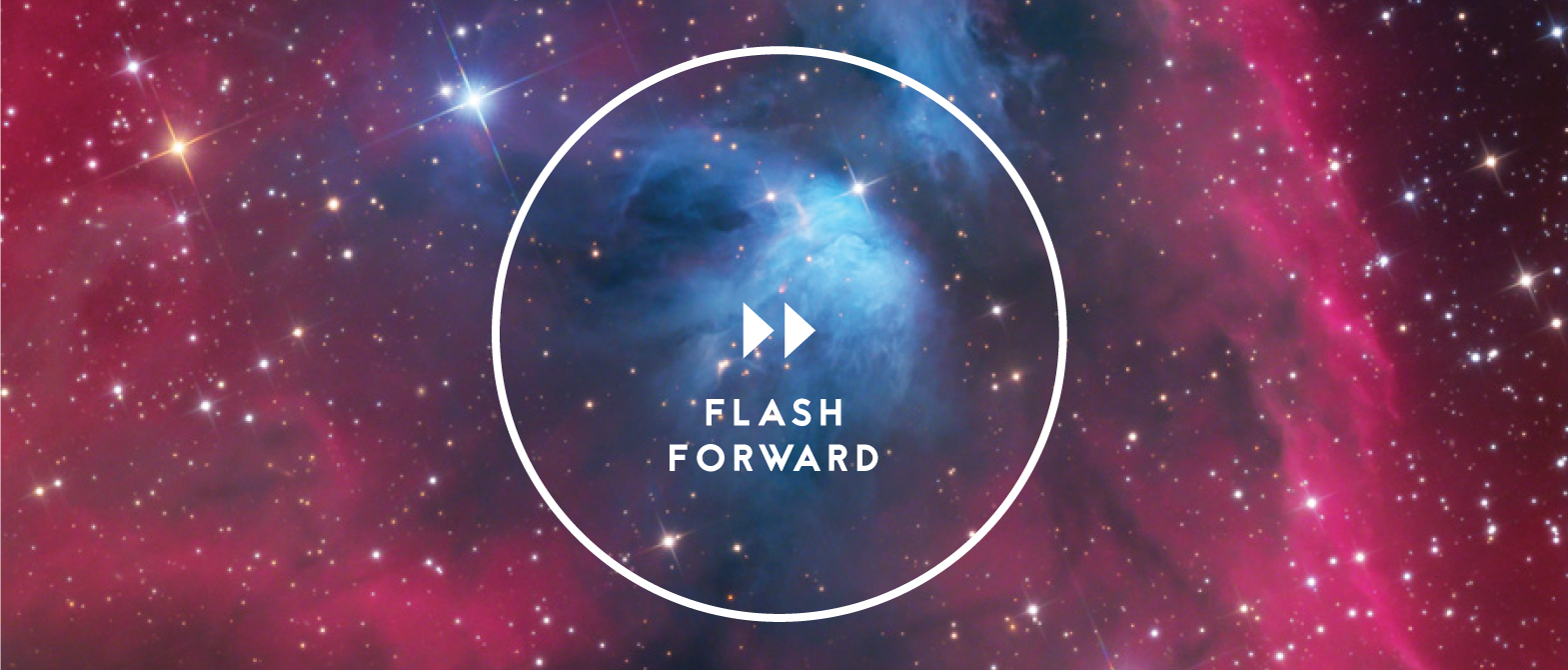
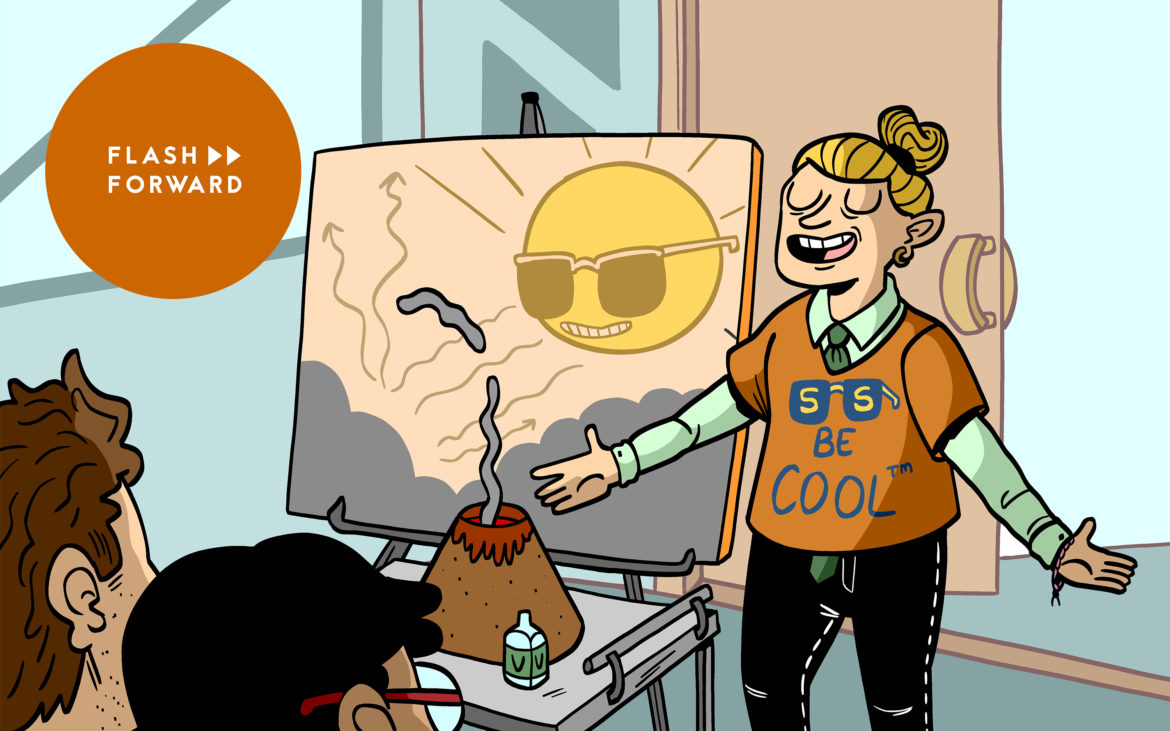

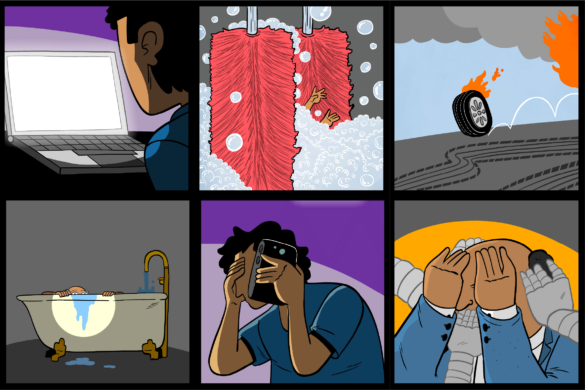
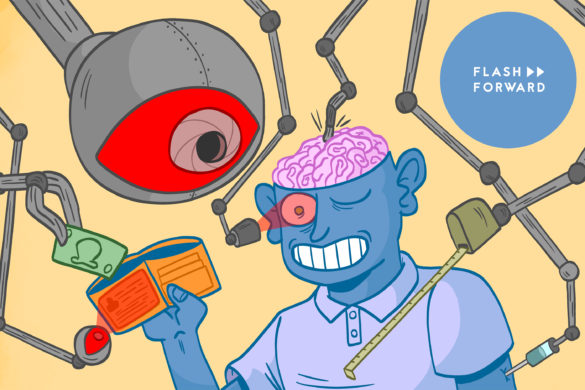

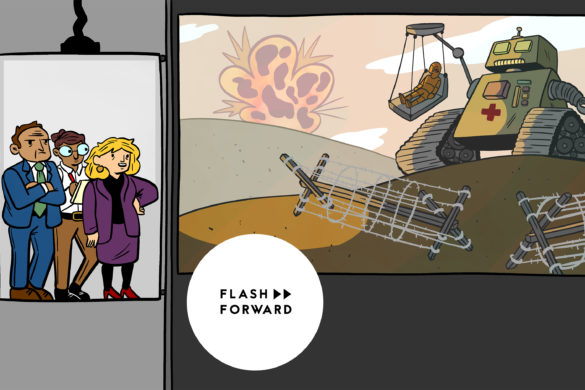
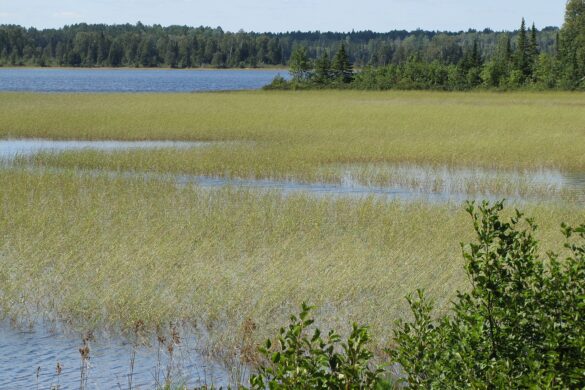
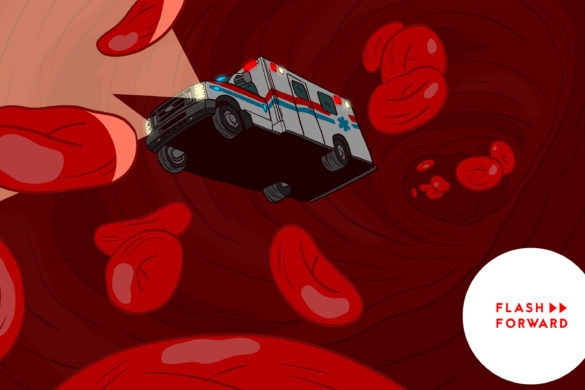


9 comments
Just started listening to the newest episode on Overcast. Something was off with the sound quality, had to skip it.
Hi there! Sorry about that, it should be fixed now!
Hi Rose, I’m listening now fine just on your site, but I think something happened to the Apple Podcast file that was uploaded. Seems like it’s missing a layer of audio (the voice layer). It’s silent for almost the whole hour except for the intro music and outro music, as well as the look into the future. Just wanted to alert you to it! Thanks for what you do!
Thanks for the heads up! It should be fixed now.
Hey, how can I download your podcast in mp3 format?
The podcast is always in .mp3 format.
Hey Rose! I loved this episode. It made me laugh a bit too much, but also was really interesting because of how relevant it was to my life. There was a climate strike recently, that my friends helped organize, and I just finished reading a few feminist philosophy of science and STS studies on scientific colonialism. In particular, the part relating to first world countries “deciding” whats best for third world countries resonated with my understanding of the problems often present in the production of scientific knowledge. I am hella excited to listen to more!
A note on the end of the episode: you claimed that male contraceptives were just around the corner (as an example of technology that so close but not there yet). I’d like to remind you that that is not completely true, rather that it was purposefully not developed because of sexist attitudes in the 70s and 80s. (c.f. Nancy Tuana- The Speculums of Ignorance).
Hi Em! The male birth control part was a joke! It’s one of those things that everybody always CLAIMS is about to happen, but never actually happens, and probably won’t happen because of a variety of factors.
[…] EARTH: The Sunshade […]